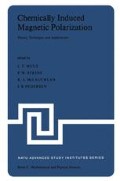Abstract
Soon after the discovery of CIDNP it was proposed that the observed nuclear spin polarizations resulted from a small deviation from equilibrium in the electron spin states of the chemically generated radicals (such as all states equally populated), which was converted by electron-nuclear cross relaxation into a large deviation of the nuclear spin states from thermal equilibrium [1, 2]. This model is often called an Overhauser mechanism, because of its similarity to the Overhauser effect in which microwave pumping of the electron spin states of a paramagnetic species in a magnetic field leads to large nuclear spin polarizations [3]. This model failed to account for many features of CIDNP, however, and it was superseded by the radical pair mechanism [4, 5]. This did not prove the Overhauser mechanism is nonexistent, however. It could be that it is usually much less efficient than the radical pair mechanism, which therefore dominates the polarization process and hides the smaller effects of the Overhauser mechanism. If so, the Overhauser mechanism could be important in cases where the radical pair mechanism is inoperative, or if there is a very large initial electron spin polarization.
This work has been supported by the U. S. Naval Sea Systems Command under Contract N00017-72-C-4401.
Access this chapter
Tax calculation will be finalised at checkout
Purchases are for personal use only
Preview
Unable to display preview. Download preview PDF.
References
J. Bargon and H. Fischer, Z. Natürforsch 22a, 1556 (1967).
R.G. Lawler, J. Am. Chem. Soc. 89, 5518 (1967).
K.H. Hauser and D. Stehlik, Adv. Magn. Reson. 3, 79 (1968).
A. Carrington and A.D. McLachlan, Introduction to Magnetic Resonance (Harper & Row, New York, 1967) pp. 229–233.
G.L. Closs, J. Am. Chem. Soc. 91, 4552 (1969).
G.L. Closs and A.D. Trifunac, J. Am. Chem. Soc. 92, 2183 (1970).
R. Kaptein and L.J. Oosterhoff, Chem. Phys. Lett. 4, 195 (1969); ibid. p. 214.
P.W. Atkins, I.C. Buchanan, R.C. Gurd, K.A. McLauchlan and A.F. Simpson, Chem. Commun., 513 (1970).
S.K. Wong, D. A. Hutchinson and J.K.S. Wan, J. Am. Chem. Soc. 95, 622 (1973).
A. J. Dobbs and K.A. McLauchlan, Chem. Phys. Lett. 30, 257 (1975).
B.B. Adeleke, K.Y. Choo and J.K.S. Wan, J. Chem. Phys. 62, 3822 (1975).
S.K. Wong, D. A. Hutchinson and J.K.S. Wan, J. Chem. Phys. 58, 985 (1973).
P.W. Atkins and G.T. Evans, Mol. Phys. 27, 1633 (1974).
F.J. Adrian, J. Chem. Phys. 61, 4875 (1975).
J. Bargon and K. G. Seifert, Ber. Bunsenges. Phys. Chem. 78, 1180 (1974).
H.M. Vyas and J.K.S. Wan, Chem. Phys. Lett. 34, 470 (1975).
F.J. Adrian, H.M. Vyas and J.K.S. Wan, J. Chem. Phys. 65, 1454 (1976).
This derivation proceeds as described for Eq.(19) of reference 8c, except that here we omit the step setting and using Eq. (3).
F.J. Adrian, Chem. Phys. Lett. 26, 437 (1974).
G.L. Closs and L.E. Closs, J. Am. Chem. Soc. 91, 4549 (1969); ibid. p. 4550.
A.A. Lamola, M.L. Manion, H.D. Roth and G. Tollin, Proc. Nat. Acad. Sci. USA 72, 3265 (1975).
E.M. Purcell and G.B. Field, Astrophys. J. 124, 542 (1956).
F.J. Adrian, J. Chem. Phys. 53, 3374 (1970).
F.J. Adrian, J. Chem. Phys. 54, 3912 (1971).
Author information
Authors and Affiliations
Editor information
Editors and Affiliations
Rights and permissions
Copyright information
© 1977 D. Reidel Publishing Company, Dordrecht, Holland
About this paper
Cite this paper
Adrian, F.J. (1977). Triplet Overhauser Mechanism of CIDNP. In: Muus, L.T., Atkins, P.W., McLauchlan, K.A., Pedersen, J.B. (eds) Chemically Induced Magnetic Polarization. Nato Advanced Study Institutes Series, vol 34. Springer, Dordrecht. https://doi.org/10.1007/978-94-010-1265-2_21
Download citation
DOI: https://doi.org/10.1007/978-94-010-1265-2_21
Publisher Name: Springer, Dordrecht
Print ISBN: 978-94-010-1267-6
Online ISBN: 978-94-010-1265-2
eBook Packages: Springer Book Archive

